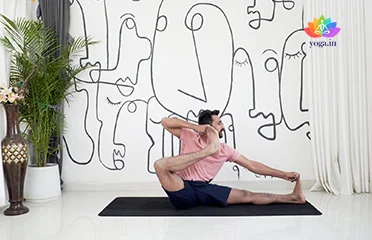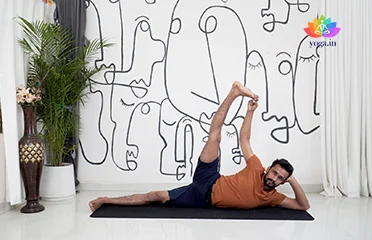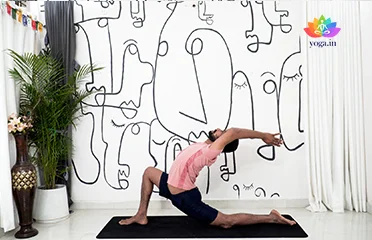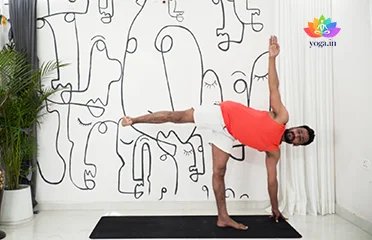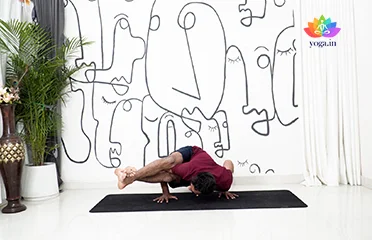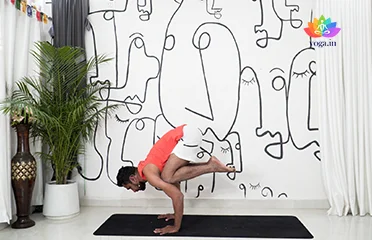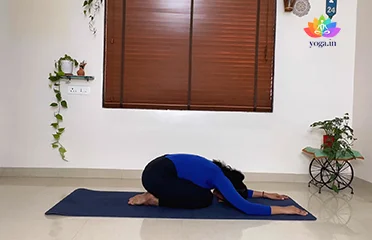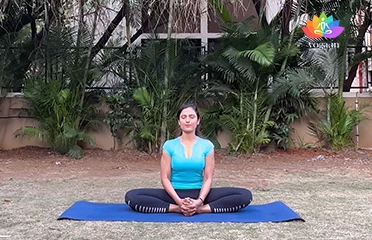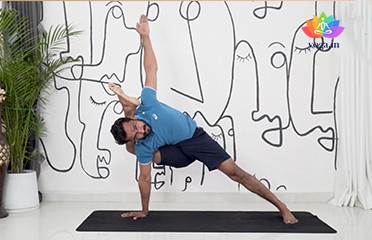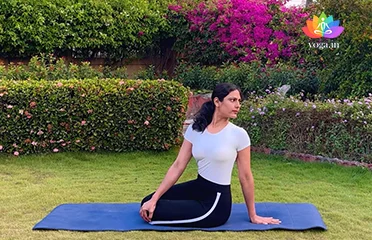Akarna Dhanurasana (Archer Pose)
अकर्णा धनुरासन / Archer Pose
The Sanskrit name is derived from Akarna (अकर्णा ) meaning towards [�K]
Anantasana (Sleeping Vishnu Pose)
अनन्तासन / Sleeping Vishnu Pose | Vishnu's Couch Pose
The Sanskrit name is derived from Ananta (अनन्त) meaning without end [�K]
Anjaneyasana (Crescent Moon Pose)
आंजनेयासन / Crescent Moon Pose
The Sanskrit name is derived from Anjane (आंजने) meaning Hanuman, [�K]
Ardha Chandrasana (Half Moon Pose)
अर्धचन्द्रासना / Half Moon Pose
The Sanskrit name is derived from Ardha (अर्ध) meaning half, Chandra [�K]
Astavakrasana (Eight-Angle Pose)
अष्टवक्रासन / Eight-Angle Pose
The sanskrit name is derived from ashta (अष्ट) meaning eight, Vakra [�K]
Bakasana (Crane Pose)
बकासन / Crane Pose
The Sanskrit name is derived from Baka (बक) meaning crane or Kaka (काक) [�K]
Balasana (Child’s Pose)
बालासना / Child's Pose
The Sanskrit name is derived from Bala (बाला) meaning child and āsana [�K]
Bhadrasana (Gracious Pose | Butterfly Po
भद्रासन / Gracious Pose | Butterfly Pose
The Sanskrit name is derived from Bhadra (भद्रा) meaning gracious, [�K]
Bhairavasana (Formidable Pose)
भैरवासन / Formidable Pose
Bhairava (भैरव, Bhairava) is a manifestation of Shiva (शिव, Śiva); [�K]
Bharadvajasana (Seated Spinal Twist)
भरद्वाजसन / Seated Spinal Twist
The Sanskrit name is derived from Bhardvaja (भरद्वाज) means bringing [�K]
- 1
- 2
- 3
- 4
- 5
- ...
- 6
- 7
How Yoga Can Help
Yoga poses for the chest focus on opening and strengthening the chest muscles, improving respiratory function, and relieving tension. These poses can help alleviate symptoms associated with chest discomfort, such as tightness, pain, and restricted breathing. By practicing specific yoga postures, individuals can enhance their lung capacity, promote better posture, and reduce stress, leading to overall chest health and well-being.
Understanding Yoga Poses for the Chest
Yoga poses for the chest are designed to expand the ribcage, stretch the pectoral muscles, and improve flexibility and strength in the upper body. These poses typically involve backbends, chest openers, and shoulder stretches that help to counteract the effects of poor posture and sedentary lifestyles. Regular practice of these poses can lead to better breathing, reduced tension, and enhanced physical and mental relaxation.
Key Factors Contributing to Chest Discomfort
Several factors can contribute to chest discomfort, including:
- Poor Posture: Slouching or sitting for prolonged periods can lead to tight chest muscles.
- Stress and Anxiety: Emotional stress can cause tension in the chest and upper body.
- Sedentary Lifestyle: Lack of physical activity can weaken the chest and shoulder muscles.
- Respiratory Issues: Conditions like asthma or bronchitis can lead to chest tightness.
- Muscle Strain: Overuse or injury to the chest muscles can cause pain and discomfort.
Symptoms of Chest Discomfort
Common symptoms of chest discomfort include:
- Tightness: A feeling of tightness or constriction in the chest area.
- Pain: Sharp or dull pain that may radiate to the shoulders or arms.
- Shortness of Breath: Difficulty in breathing or a feeling of breathlessness.
- Stiffness: Reduced flexibility and movement in the chest and upper body.
- Fatigue: General tiredness and lack of energy due to restricted breathing.
Yoga’s Role in Relieving Chest Discomfort
Specific yoga practices and techniques can alleviate symptoms of chest discomfort by promoting relaxation and improving muscle function. Key yoga poses for the chest include:
- Bhujangasana (Cobra Pose): Strengthens the spine and opens the chest.
- Ustrasana (Camel Pose): Stretches the front of the body, including the chest and abdomen.
- Matsyasana (Fish Pose): Expands the chest and stimulates the respiratory system.
- Setu Bandhasana (Bridge Pose): Opens the chest and strengthens the back muscles.
Pranayama Exercises:
- Ujjayi Breathing (Ocean Breath): Calms the mind and enhances lung function.
- Kapalabhati (Skull Shining Breath): Clears the respiratory system and energizes the body.
Diet for Chest Health
A balanced diet can support chest health. Recommendations include:
- Anti-Inflammatory Foods: Incorporate foods like turmeric, ginger, and leafy greens.
- Lean Proteins: Include chicken, fish, beans, and lentils to support muscle health.
- Omega-3 Fatty Acids: Found in fish, flaxseeds, and walnuts to reduce inflammation.
- Hydration: Drink plenty of water to stay hydrated and support respiratory function.
Caution for Yoga Poses for the Chest
While practicing yoga for chest health, it is essential to:
- Avoid Overexertion: Do not push yourself too hard; practice at a comfortable pace.
- Be Mindful of Pain: If you experience pain, stop the pose and rest.
- Consult a Professional: Seek advice from a yoga instructor if you have any health concerns.
Contraindications for Yoga Poses for the Chest
Individuals with certain conditions should avoid specific yoga practices:
- Severe Respiratory Issues: Consult a healthcare provider before practicing.
- Chest Injuries: Avoid poses that strain the chest muscles.
- Heart Conditions: Seek professional guidance before starting a yoga regimen.


